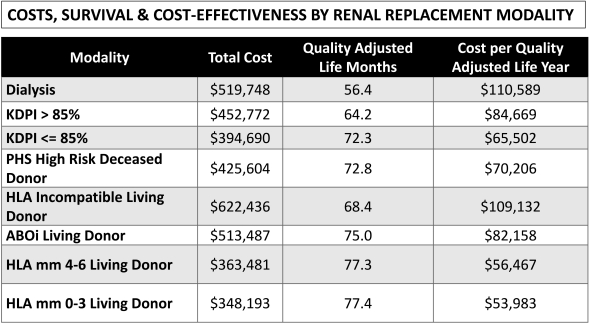Economic Evaluation of Contemporary Kidney Transplant Practice
1Lahey Clinic, Burlington
2Saint Louis University, St. Louis
3East Carolina University, Greeneville
4Washington University, St. Louis
5Hennepin County, Minneapolis.
Meeting: 2018 American Transplant Congress
Abstract number: 367
Keywords: Donors, Economics, High-risk, Kidney transplantation, marginal
Session Information
Session Name: Concurrent Session: Non-Organ Specific: Economics, Public Policy, Allocation, Ethics - 1
Session Type: Concurrent Session
Date: Monday, June 4, 2018
Session Time: 4:30pm-6:00pm
 Presentation Time: 5:06pm-5:18pm
Presentation Time: 5:06pm-5:18pm
Location: Room 4C-4
Kidney transplantation (KTx) has been established as the optimal therapy for medically suitable patients with end-stage renal disease, prolonging survival and reducing health care spending. However, previously published KTx economics have assumed compatible donors of average or better quality. The economic implication of KTx in contemporary practice including the use of high kidney donor profile index (KPDI) and public health service high risk (PHS) deceased donors, as well transplantation from ABO or HLA incompatible living donors, has not been assessed.
Using contemporary modeling techniques including Discrete Event Simulation (DES) over a 10-year time horizon, we compared the cost-effectiveness of KTx from varying donor types and dialysis for patients with kidney failure. DES models were constructed using data drawn from the United States Renal Data System, the SRTR transplant registry, University HealthSystem Consortium, and literature review. Graft failure rates, transplant cost, and disease transmission events were adjusted for donor characteristics.
All KTx options resulted in improved patient survival compared to long term dialysis; however, the relative benefits and costs differed substantially (Table). Over a 10 year period, living donor KTx with 0-3 HLA mismatches (mm) yielded 77.3 Quality Adjusted Life Months (QALM) at a cost of $53,982 per quality adjusted life year (QALY). By comparison, dialysis provided only 56.4 QALMs at a cost of $110,580 per QALY. HLA incompatible living donor KTx was more expensive than dialysis, but resulted in an additional 12 QALM of survival over 10 years. Sensitivity analysis suggests that these results are robust over a clinically relevant range of inputs.
KTx is cost-effective over across a spectrum of donor characteristics, despite higher costs for marginal organs and innovative living donor KTx practices.
CITATION INFORMATION: Axelrod D., Schnitzler M., Xiao H., Irish W., Tuttle-Newhall J., Chang S-.H., Kasiske B., Alhamad T., Lentine K. Economic Evaluation of Contemporary Kidney Transplant Practice Am J Transplant. 2017;17 (suppl 3).
To cite this abstract in AMA style:
Axelrod D, Schnitzler M, Xiao H, Irish W, Tuttle-Newhall J, Chang S-H, Kasiske B, Alhamad T, Lentine K. Economic Evaluation of Contemporary Kidney Transplant Practice [abstract]. https://atcmeetingabstracts.com/abstract/economic-evaluation-of-contemporary-kidney-transplant-practice/. Accessed January 5, 2026.« Back to 2018 American Transplant Congress

